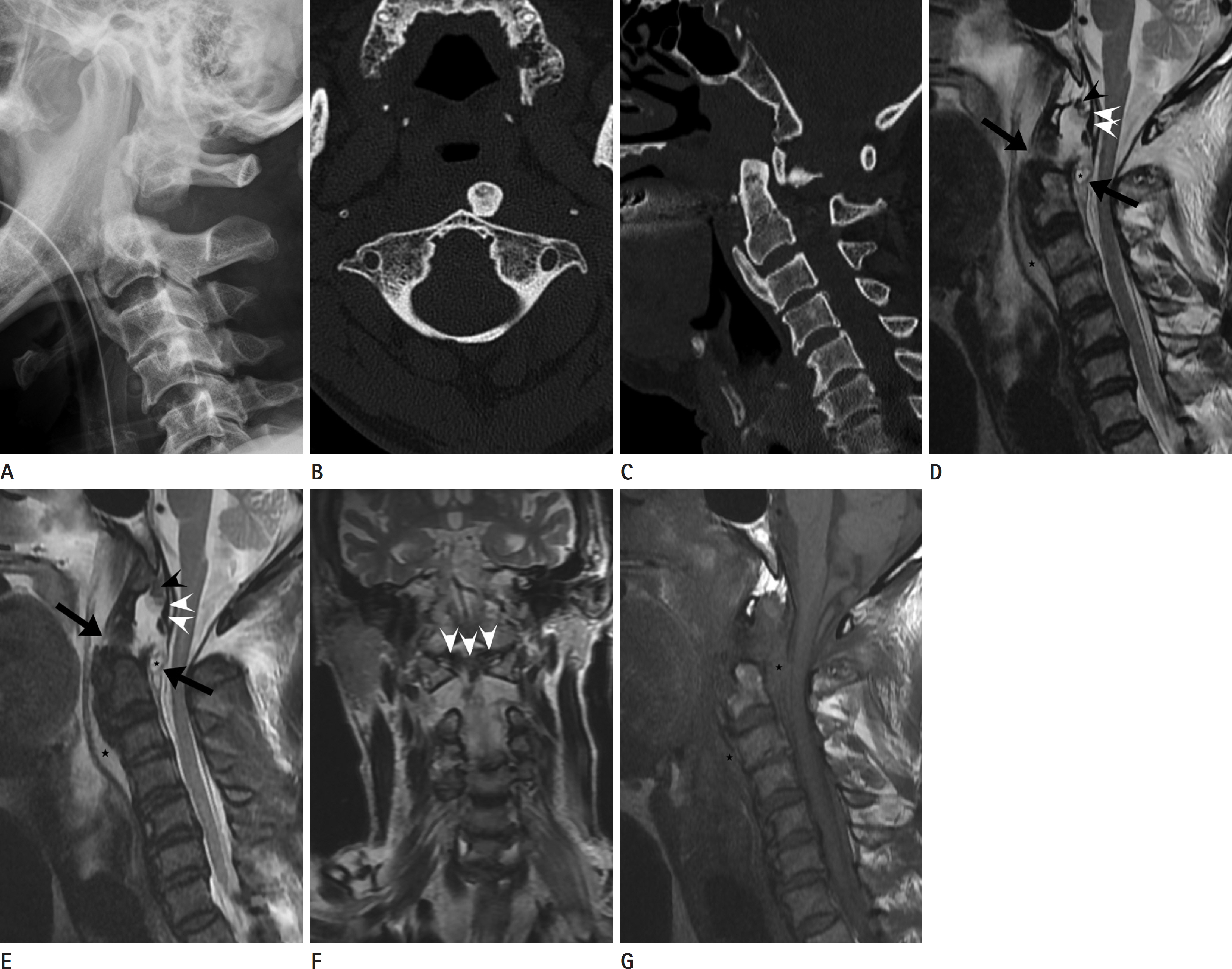J Korean Soc Radiol.
2017 Mar;76(3):233-236. 10.3348/jksr.2017.76.3.233.
Traumatic Posterior Atlantoaxial Dislocation without Fracture of the Odontoid Process: A Case Report and Literature Review
- Affiliations
-
- 1Department of Radiology, Chonnam National University Hospital, Gwangju, Korea.
- 2Department of Radiology, Chonnam National University Medical School, Gwangju, Korea.
- 3Department of Radiology, Chonnam National University Hwasun Hospital, Hwasun, Korea.
- 4Department of Radiology, Chonnam National University Bitgoeul Hospital, Gwangju, Korea. vet-lee@hanmail.net
- KMID: 2371692
- DOI: http://doi.org/10.3348/jksr.2017.76.3.233
Abstract
- Traumatic posterior atlantoaxial dislocation without odontoid fracture is very rare. Patient prognosis depends on the neurologic symptoms or the extent of damage to the structures. In this case, a 78-year-old-male suffered a posterior atlantoaxial dislocation without odontoid fracture after a traffic accident. We report this case because an exact diagnosis and proper treatment can reduce the neurologic complications in patients with posterior atlantoaxial dislocation.
MeSH Terms
Figure
Reference
-
1. Garber JN. Abnormalities of the atlas and axis vertebrae–congenital and traumatic. J Bone Joint Surg Am. 1964; 46:1782–1791.
Article2. Alker GJ Jr, Oh YS, Leslie EV. High cervical spine and cra-niocervical junction injuries in fatal traffic accidents: a ra-diological study. Orthop Clin North Am. 1978; 9:1003–1010.
Article3. Xu Y, Li F, Guan H, Xiong W. Traumatic posterior atlantoaxial dislocation without associated fracture but with neu-rological deficit: a case report and literature review. Medicine (Baltimore). 2015; 94:e1768.4. Steinmetz MP, Mroz TE, Benzel EC. Craniovertebral junction: biomechanical considerations. Neurosurgery. 2010; 66(3 Suppl):7–12.5. Haralson RH 3rd, Boyd HB. Posterior dislocation of the atlas on the axis without fracture. Report of a case. J Bone Joint Surg Am. 1969; 51:561–566.6. Sud S, Chaturvedi S, Buxi TB, Singh S. Posterior atlantoaxial dislocation without associated fracture. Skeletal Radiol. 2002; 31:529–531.7. Doherty BJ, Heggeness MH. Quantitative anatomy of the second cervical vertebra. Spine (Phila Pa 1976). 1995; 20:513–517.
Article8. Tucker SK, Taylor BA. Spinal canal capacity in simulated displacements of the atlantoaxial segment: a skeletal study. J Bone Joint Surg Br. 1998; 80:1073–1078.9. Chaudhary R, Chaudhary K, Metkar U, Rathod A, Raut A, Sanghvi D. Posterior atlantoaxial dislocation without odontoid fracture. Skeletal Radiol. 2008; 37:361–366.
Article10. Wong DA, Mack RP, Craigmile TK. Traumatic atlantoaxial dislocation without fracture of the odontoid. Spine (Phila Pa 1976). 1991; 16:587–589.
Article
- Full Text Links
- Actions
-
Cited
- CITED
-
- Close
- Share
- Similar articles
-
- A Case of Pediatric Odontoid Base Fracture Treated by Halovest Fixation
- Atlanto-axial Dislocation with the Fracture of the Odontoid Process: A Case Report
- Congenital Agenesis of Odonteid Process: A Case Report
- Treatment of Traumatic Sternoclavicular Joint Anterior Dislocation with a Sternal Fracture
- Irreducible Atlanto-Axial Dislocation in Neglected Odontoid Fracture Treated with Single Stage Anterior Release and Posterior Instrumented Fusion


